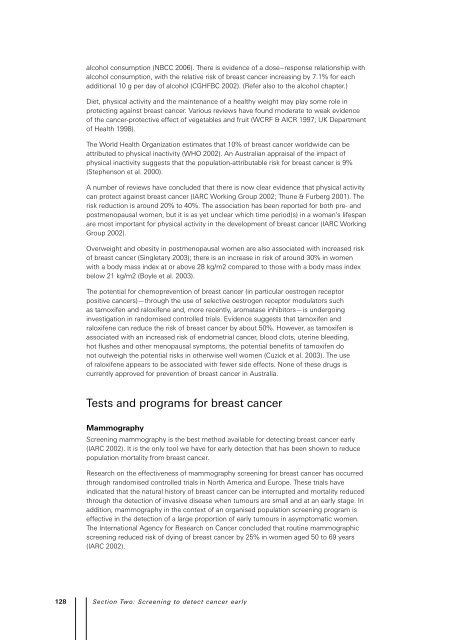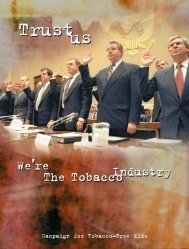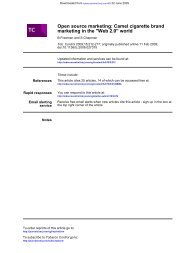National Cancer Prevention Policy - Tobacco Control Supersite
National Cancer Prevention Policy - Tobacco Control Supersite
National Cancer Prevention Policy - Tobacco Control Supersite
Create successful ePaper yourself
Turn your PDF publications into a flip-book with our unique Google optimized e-Paper software.
alcohol consumption (NBCC 2006). There is evidence of a dose−response relationship with<br />
alcohol consumption, with the relative risk of breast cancer increasing by 7.1% for each<br />
additional 10 g per day of alcohol (CGHFBC 2002). (Refer also to the alcohol chapter.)<br />
Diet, physical activity and the maintenance of a healthy weight may play some role in<br />
protecting against breast cancer. Various reviews have found moderate to weak evidence<br />
of the cancer-protective effect of vegetables and fruit (WCRF & AICR 1997; UK Department<br />
of Health 1998).<br />
The World Health Organization estimates that 10% of breast cancer worldwide can be<br />
attributed to physical inactivity (WHO 2002). An Australian appraisal of the impact of<br />
physical inactivity suggests that the population-attributable risk for breast cancer is 9%<br />
(Stephenson et al. 2000).<br />
A number of reviews have concluded that there is now clear evidence that physical activity<br />
can protect against breast cancer (IARC Working Group 2002; Thune & Furberg 2001). The<br />
risk reduction is around 20% to 40%. The association has been reported for both pre- and<br />
postmenopausal women, but it is as yet unclear which time period(s) in a woman’s lifespan<br />
are most important for physical activity in the development of breast cancer (IARC Working<br />
Group 2002).<br />
Overweight and obesity in postmenopausal women are also associated with increased risk<br />
of breast cancer (Singletary 2003); there is an increase in risk of around 30% in women<br />
with a body mass index at or above 28 kg/m2 compared to those with a body mass index<br />
below 21 kg/m2 (Boyle et al. 2003).<br />
The potential for chemoprevention of breast cancer (in particular oestrogen receptor<br />
positive cancers)—through the use of selective oestrogen receptor modulators such<br />
as tamoxifen and raloxifene and, more recently, aromatase inhibitors—is undergoing<br />
investigation in randomised controlled trials. Evidence suggests that tamoxifen and<br />
raloxifene can reduce the risk of breast cancer by about 50%. However, as tamoxifen is<br />
associated with an increased risk of endometrial cancer, blood clots, uterine bleeding,<br />
hot flushes and other menopausal symptoms, the potential benefits of tamoxifen do<br />
not outweigh the potential risks in otherwise well women (Cuzick et al. 2003). The use<br />
of raloxifene appears to be associated with fewer side effects. None of these drugs is<br />
currently approved for prevention of breast cancer in Australia.<br />
Tests and programs for breast cancer<br />
Mammography<br />
Screening mammography is the best method available for detecting breast cancer early<br />
(IARC 2002). It is the only tool we have for early detection that has been shown to reduce<br />
population mortality from breast cancer.<br />
Research on the effectiveness of mammography screening for breast cancer has occurred<br />
through randomised controlled trials in North America and Europe. These trials have<br />
indicated that the natural history of breast cancer can be interrupted and mortality reduced<br />
through the detection of invasive disease when tumours are small and at an early stage. In<br />
addition, mammography in the context of an organised population screening program is<br />
effective in the detection of a large proportion of early tumours in asymptomatic women.<br />
The International Agency for Research on <strong>Cancer</strong> concluded that routine mammographic<br />
screening reduced risk of dying of breast cancer by 25% in women aged 50 to 69 years<br />
(IARC 2002).<br />
12 Section Two: Screening to detect cancer early




